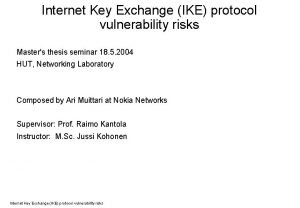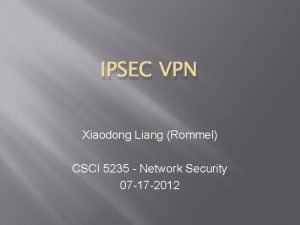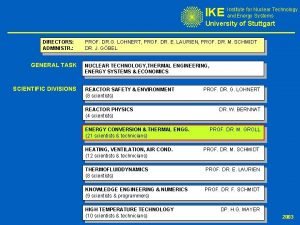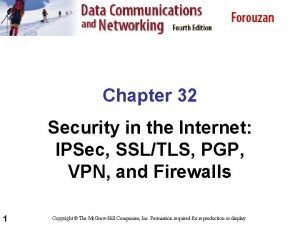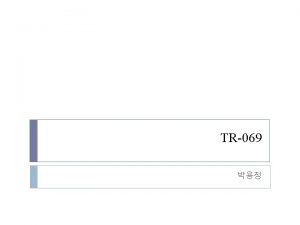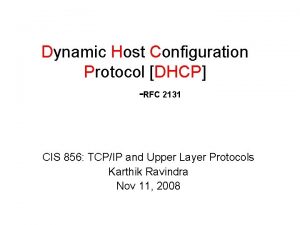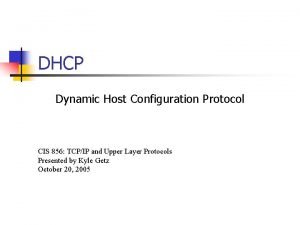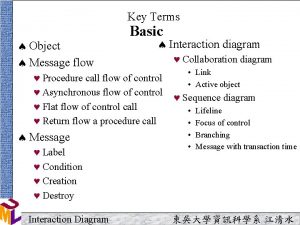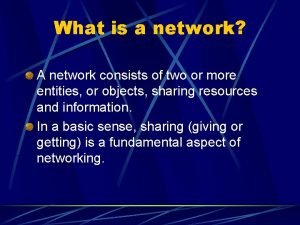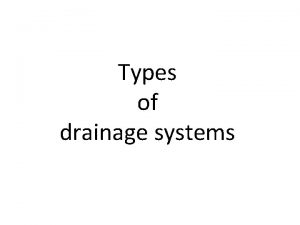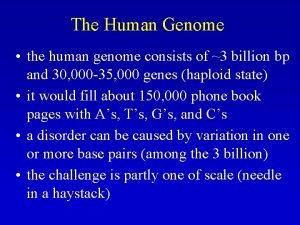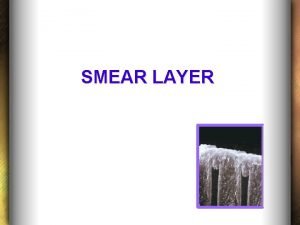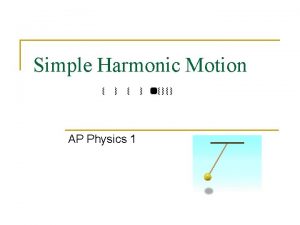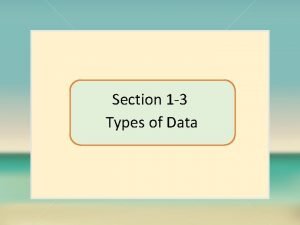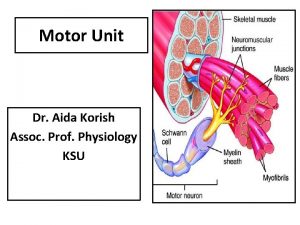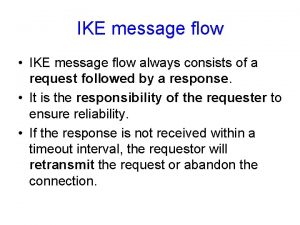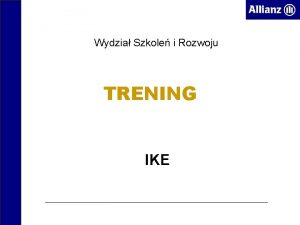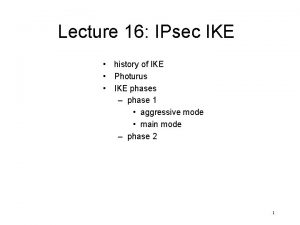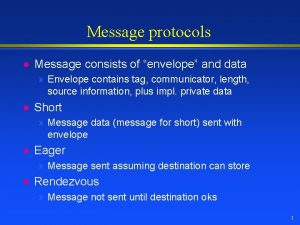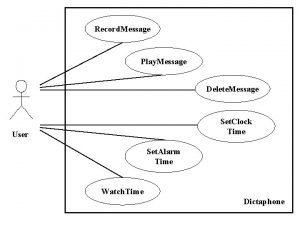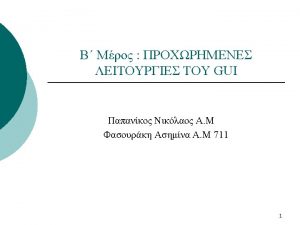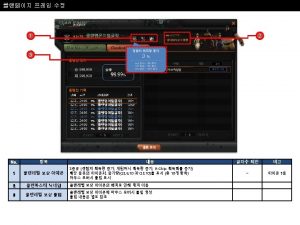IKE message flow IKE message flow always consists






![INIT response The responder sends the following message: HDR, SAr 1, KEr, Nr [CERTREQ] INIT response The responder sends the following message: HDR, SAr 1, KEr, Nr [CERTREQ]](https://slidetodoc.com/presentation_image_h/825da6ce2a28c97659a70bded850d422/image-7.jpg)


![Authentication request àHDR, SK{ IDi, [CERT, ] [CERTREQ, ] [IDr, ] AUTH, SAi 2, Authentication request àHDR, SK{ IDi, [CERT, ] [CERTREQ, ] [IDr, ] AUTH, SAi 2,](https://slidetodoc.com/presentation_image_h/825da6ce2a28c97659a70bded850d422/image-10.jpg)
![Authentication request àHDR, SK{ IDi, [CERT, ] [CERTREQ, ] [IDr, ] AUTH, SAi 2, Authentication request àHDR, SK{ IDi, [CERT, ] [CERTREQ, ] [IDr, ] AUTH, SAi 2,](https://slidetodoc.com/presentation_image_h/825da6ce2a28c97659a70bded850d422/image-11.jpg)
![Authentication response HDR, SK{ IDr, [CERT, ] AUTH, SAr 2, TSi, TSr} • IDr Authentication response HDR, SK{ IDr, [CERT, ] AUTH, SAr 2, TSi, TSr} • IDr](https://slidetodoc.com/presentation_image_h/825da6ce2a28c97659a70bded850d422/image-12.jpg)







![CHILD-SA request A CREATE_CHILD_SA request: àHDR, SK{ SA, Ni, [KEi, ] [TSi, TSr] } CHILD-SA request A CREATE_CHILD_SA request: àHDR, SK{ SA, Ni, [KEi, ] [TSi, TSr] }](https://slidetodoc.com/presentation_image_h/825da6ce2a28c97659a70bded850d422/image-20.jpg)
![CHILD-SA response A CREATE_CHILD_SA response: HDR, SK{ SA, Nr, [KEr, ] [TSi, TSr] } CHILD-SA response A CREATE_CHILD_SA response: HDR, SK{ SA, Nr, [KEr, ] [TSi, TSr] }](https://slidetodoc.com/presentation_image_h/825da6ce2a28c97659a70bded850d422/image-21.jpg)









- Slides: 30

IKE message flow • IKE message flow always consists of a request followed by a response. • It is the responsibility of the requester to ensure reliability. • If the response is not received within a timeout interval, the requestor will retransmit the request or abandon the connection.

SA terminology • IKE-SA used to secure IKE communication. • CHILD-SA Created by the IKE to be used in ESP or AH security.

The two IKE phases • Phase 1 Establishment of an IKE-SA Mutual authentication Creation of the first CHILD-SA. (An expensive process which is done rarely) • Phase 2 establishing additional CHILD-SA’s and performing “housekeeping functions”

Phase 1 • Establishes an IKE-SA that includes shared secret information that can be used to efficiently establish Child-SA’s. • Performs mutual authentication • Creates the first Child-SA • Consists of two stages

Stage 1 - INIT • Negotiates cryptographic algorithms • Exchanges nonces • Performs a Diffie-Hellman exchange Note: messages are not protected

INIT request The initiator sends the following message: àHDR, SAi 1, KEi, Ni • HDR – header contains SPI, version, flags • SAi 1 – states the cryptographic algorithms the initiator supports • KEi – initiator’s DH value. • Ni – initiator’s nonce.
![INIT response The responder sends the following message HDR SAr 1 KEr Nr CERTREQ INIT response The responder sends the following message: HDR, SAr 1, KEr, Nr [CERTREQ]](https://slidetodoc.com/presentation_image_h/825da6ce2a28c97659a70bded850d422/image-7.jpg)
INIT response The responder sends the following message: HDR, SAr 1, KEr, Nr [CERTREQ] • SAr 1 – states the cryptographic algorithms the responder selected. • KEr – responder’s Difie-Hellman value. • Nr – responder’s nonce. • CERTREQ – optional certificate request

SKEYSEED generation • Each party generates the SKEYSEED which is used to derive the keys used in IKE-SA. Notice: separate keys are computed for each direction

Authentication stage • Authenticates the previous messages • Exchanges and proves identities • Establishes the first CHILD-SA • Messages are protected using the keys derived at the INIT stage. • Identity protection is achieved
![Authentication request àHDR SK IDi CERT CERTREQ IDr AUTH SAi 2 Authentication request àHDR, SK{ IDi, [CERT, ] [CERTREQ, ] [IDr, ] AUTH, SAi 2,](https://slidetodoc.com/presentation_image_h/825da6ce2a28c97659a70bded850d422/image-10.jpg)
Authentication request àHDR, SK{ IDi, [CERT, ] [CERTREQ, ] [IDr, ] AUTH, SAi 2, TSi, TSr } • IDi – initiator’s identity • CERT, CERTREQ – optionally presenting or requesting certificates • IDr – specifiying the responder’s desired identity * SK{…} indicates encription and integrity protection using SK_e and SK_a
![Authentication request àHDR SK IDi CERT CERTREQ IDr AUTH SAi 2 Authentication request àHDR, SK{ IDi, [CERT, ] [CERTREQ, ] [IDr, ] AUTH, SAi 2,](https://slidetodoc.com/presentation_image_h/825da6ce2a28c97659a70bded850d422/image-11.jpg)
Authentication request àHDR, SK{ IDi, [CERT, ] [CERTREQ, ] [IDr, ] AUTH, SAi 2, TSi, TSr } • AUTH – authenticates the previous message and the initiator’s identity. (a digital signature over the first message) • SAi 2, TSi, TSr – needed for first CHILD-SA
![Authentication response HDR SK IDr CERT AUTH SAr 2 TSi TSr IDr Authentication response HDR, SK{ IDr, [CERT, ] AUTH, SAr 2, TSi, TSr} • IDr](https://slidetodoc.com/presentation_image_h/825da6ce2a28c97659a70bded850d422/image-12.jpg)
Authentication response HDR, SK{ IDr, [CERT, ] AUTH, SAr 2, TSi, TSr} • IDr – responder’s identity • CERT – presenting certificates • AUTH - authenticates the previous message and the resonder’s identity. • SAr 2, TSi, TSr - needed for first CHILD-SA

End of phase 1 • Signatures are verified • First CHILD-SA is established

Possible DOS attack • The response to the first Phase 1 message involves expensive computations • This can be exploited in a DOS attack where the attacker use IP Spoofing to flood the victim with requests to open connection. • Can be solved using cookies

Cookies • A Cookie is a field which is sent to the connection initiator. • The initiator is expected to return the cookie. • A returned cookie is a proof that the initiator can receive packets destined to the IP address he declared.

The use of cookies • When a responder detects many half-open connections, a new policy is used. • Each new connection request that does not contain a valid cookie is rejected. • The rejection message contains a cookie and a demand for this cookie in a future connection request.

Cookie demands • No one but the creator can construct a valid cookie • Cheap to create • No resources needs to be allocated to handle each cookie

Cookie creation • Cookie = HASH(<secret> | IPi | SPI | TS) • • <secret> - a secret known only to the responder IPi – IP address of the initiator SPI – included in the request TS – time stamp (A possible problem …)

Phase 2 Creating a new CHILD-SA: • Relatively cheap operation • Can be initiated by either endpoints • Provides optional perfect-forward-secrecy All other information flow: • Will be discussed later
![CHILDSA request A CREATECHILDSA request àHDR SK SA Ni KEi TSi TSr CHILD-SA request A CREATE_CHILD_SA request: àHDR, SK{ SA, Ni, [KEi, ] [TSi, TSr] }](https://slidetodoc.com/presentation_image_h/825da6ce2a28c97659a70bded850d422/image-20.jpg)
CHILD-SA request A CREATE_CHILD_SA request: àHDR, SK{ SA, Ni, [KEi, ] [TSi, TSr] } • • SA – The initiator’s offers for the new SA Ni - Initiator’s nonce KEi – a new DH value TSi, TSr – proposed traffic selectors
![CHILDSA response A CREATECHILDSA response HDR SK SA Nr KEr TSi TSr CHILD-SA response A CREATE_CHILD_SA response: HDR, SK{ SA, Nr, [KEr, ] [TSi, TSr] }](https://slidetodoc.com/presentation_image_h/825da6ce2a28c97659a70bded850d422/image-21.jpg)
CHILD-SA response A CREATE_CHILD_SA response: HDR, SK{ SA, Nr, [KEr, ] [TSi, TSr] } • SA – The responder chosen SA offer • Nr - Responder’s nonce • KEr – A new DH value (if the request had a Kei) • TSi, TSr – selected traffic selectors

PFS in IKE Reminder: Perfect forward secrecy means that once a connection is closed and its keys are forgotten, even someone who recorded all the data from the connection, and gets access to the long term keys used to protect it, cannot reconstruct the keys of a CHILD-SA that was created during the connection.

Achieving CHILD-SA PFS • The optional KE field in the establishment of a new CHILD-SA indicates that the keys created depend on a unique DH key exchange. Such keys achieve the PFS quality. • Expensive procedure. • Depends on two conditions …

Generating keying material • In the establishment of the IKE-SA a pseudo-random function (prf) is negotiated. • The keying material for all SA’s is derived from the output string of the prf.

Prf usage • Usually the amount of keying material needed is greater then the prf output. • The prf is used iteretively: Prf+ (K , S) = T 1 | T 2 | T 3 | … where: T 1 = prf (K , S | 0 x 01) T 2 = prf (K , T 1 | S | 0 x 02) T 3 = prf (K , T 2 | S | 0 x 03)

IKE-SA keying material • After INIT (in Phase 1), SKEYSEED is calculated: SKEYSEED = prf (Ni | Nr , g^ir) • Ni, Nr – nonces of both parties • G^ir – the DH key

IKE-SA keys derived Five keys are derived. • SK_d – used in deriving CHILD-SA keys • SK_ai, SK_ar – authentication keys • SK_ei, SK_er – encryption keys Notice: different keys for each direction

IKE-SA keys deriviation { SK_d , SK_ai , SK_ar , SK_ei , SK_er } = Prf+ (SKEYSEED , g^ir | Ni | Nr | CKY-I | CKY-R) • CKY-I , CKY-R – the cookie of both parties

CHILD-SA keying material Creation without PFS: KEYMAT = prf+ (SK_d, Ni | Nr) Creation with PFS: KEYMAT = prf+ (sk_d, g^ir | Ni | Nr ) g^ir is the DH key established for this CHILD_SA

CHILD-SA keying derivation • All keys needed for the SA created are derived from the KEYMAT (depends on the needs of the algorithms using this SA) • Multiple SA’s can be created at a single CHILD_SA negotiation.
 Always low prices always
Always low prices always Sonia ike
Sonia ike Ike poe
Ike poe Direct characterization of jem in to kill a mockingbird
Direct characterization of jem in to kill a mockingbird Juan achmad yudistira
Juan achmad yudistira Ike protocol
Ike protocol Teknik analisis data kualitatif model spradley
Teknik analisis data kualitatif model spradley Cse 5235
Cse 5235 Ike stuttgart
Ike stuttgart Tsia tsia searching for connection
Tsia tsia searching for connection Ike creates sas for
Ike creates sas for Cpe wan management protocol
Cpe wan management protocol Dhcp state transition diagram
Dhcp state transition diagram 99/130 simplified
99/130 simplified Sequence organization in interaction
Sequence organization in interaction Ap physics energy
Ap physics energy The following are hot sandwiches except
The following are hot sandwiches except Network consists of
Network consists of Two pipe system drainage
Two pipe system drainage Great britain consists of three parts
Great britain consists of three parts Human genome consists of
Human genome consists of Define smear layer
Define smear layer A slingshot consists of a light leather cup
A slingshot consists of a light leather cup It consists of numbers representing counts or measurements
It consists of numbers representing counts or measurements The process consists of
The process consists of Roulette probability questions
Roulette probability questions Autonomic nervous system consists of
Autonomic nervous system consists of Motor unit consists of
Motor unit consists of A marketing information system (mis) consists of:
A marketing information system (mis) consists of: Market environment definition
Market environment definition Manpower planning consists of
Manpower planning consists of





